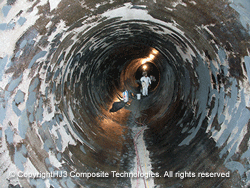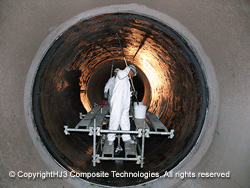Summer Weather Causes Water Main Breaks
Combating Water Main Breaks with Carbon Fiber Solutions
As summer approaches, many cities in northern regions are dealing with the aftermath of a harsh winter. The extreme cold and heavy snowfall have left their mark, and now as temperatures rise, new challenges are emerging—like melting snow runoff and broken water pipes. This time of year is often called "water main break season," a recurring issue that affects communities worldwide. In Prince Albert, Saskatchewan, a persistent water main break has been flooding the streets for over a month, highlighting the urgent need for better infrastructure solutions.The Causes Behind Water Main Breaks
One of the main causes of water main breaks is the freeze-thaw cycle. As the ground thaws, it can cause uneven settling, putting pressure on underground pipes. Combined with aging infrastructure—some of which is nearly 100 years old—this creates a perfect storm for failures. In Prince Albert alone, there have been 19 water main breaks this season, with more expected. City officials admit that the extreme cold last winter put a lot of stress on the underground system, making repairs more challenging than ever.Tackling Corrosion in Aging Pipes
Corrosion in pre-stressed concrete cylinder pipes (PCCP) is a major problem across North America. According to a 2002 study, corrosion costs U.S. water and wastewater systems over $50 billion each year. On average, 850 water main breaks occur daily, costing more than $3 billion annually in repairs. Leaks from these breaks result in the loss of about 2.5 trillion gallons of drinking water yearly—equivalent to 17% of all water pumped in the U.S. Shockingly, 90% of this loss is due to corrosion in aging pipes. A 2012 study by Utah State University found that 43% of U.S. water mains are between 20 and 50 years old, while 22% are over 50 years old.With almost half of the one million miles of pipelines under American streets reaching the end of their lifespan, replacement costs could exceed $1 trillion over the next 25 years. But with limited funding available, we need effective ways to extend the life of our aging infrastructure. That’s where innovative solutions like HJ3’s CarbonSeal come in.
HJ3's CarbonSeal: A Game-Changer in Pipe Repair
HJ3’s CarbonSeal carbon fiber system offers a smart and durable alternative to traditional repair methods. One notable case involved a cracked water pipe at a coal-fired power plant. The internal concrete lining of a 120-inch diameter pipe had developed cracks, allowing water to seep in and corrode the pre-stressed wires. As the wires weakened, the pipe lost its structural integrity. Instead of replacing the entire 750-foot section, the plant chose to use HJ3’s CarbonSeal system for a faster, more cost-effective solution.The Repair Process with CarbonSeal
The process began with an abrasive blast to clean the pipe surface, followed by the injection of polyurethane foam into the leaks. After priming the surface, the saturated CarbonSeal fabric was carefully applied. A protective top coat was then added to ensure a smooth, pinhole-free finish. The entire 750 feet of pipe was repaired in just 11 days, restoring its ability to handle internal stresses. Compared to other repair methods, this approach saved 50%, and 65% compared to full replacement. It also prevented six tons of concrete from going to landfills. After eight years, the system continues to perform well, meeting all expectations.Why Choose CarbonSeal?
If you're facing a water main or pipeline issue and want to explore modern, sustainable repair options, HJ3’s CarbonSeal system could be the answer. With expert support from design to installation, it offers a reliable and cost-efficient way to extend the life of your infrastructure. Contact HJ3 today to learn more about how they can help you protect your pipes and save money in the long run.
![PNM-1[1]](http://bsg-i.nbxc.com/blog/0cea1ad9232aeaed06638a149fc83342.jpeg)

Anti-Scratch Film is designed to offer superior protection against scratches, ensuring that your printed materials and packaging maintain a pristine appearance over time. This film is particularly valuable in high-traffic industries where durability and long-lasting quality are essential. One popular option in the market is BOPP Matt Thermal Lamination Film, which provides a matte finish that not only enhances the visual appeal of the material but also adds an extra layer of protection against scratches. The BOPP Film Thermal category also includes various protective films designed to withstand daily wear and tear, keeping your products looking new for longer. Thermal Lamination Film Manufacturers specialize in producing high-quality, scratch-resistant films, ensuring that businesses receive durable and reliable solutions tailored to their specific needs. Whether you require a smooth matte finish or a scratch-resistant surface, Anti-Scratch Films offer the perfect combination of protection and style.
bopp matt thermal lamination film,anti-scratch film,thermal lamination film manufacturers
GR (SHANDONG) NEW MATERIAL CO., LTD , https://www.grmaterial-film.com